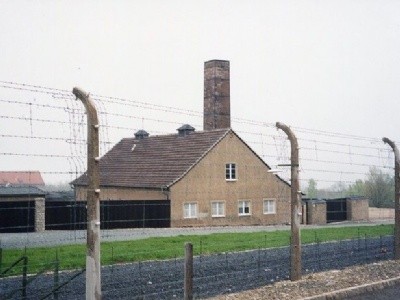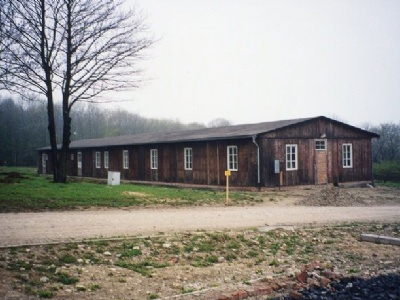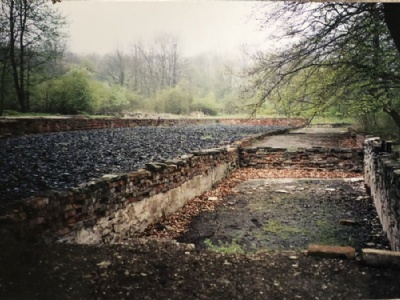Buchenwald
In the summer of 1937, the Nazis established one of the largest concentration camps on a hill called Ettersberg, about ten kilometres north of Weimar. But instead of name it Ettersberg the camp was named Buchenwald after the name of a small village nearby. The reason for that is because the name Ettersberg was too strongly associated with the philosopher Johann Wolfgang Göthe (1749 – 1832). The camp was divided into three parts and first thing the prisoners met when they came to Buchenwald was an inscription on the camp gate, Jedem das sein, roughly translated, everyone gets what he deserves. The first part was called the great camp and it was there that the prisoners were housed, the second part was for the small camp for quarantined prisoners and the last part was a tent camp set up for Poles in connection with the German invasion of Poland in 1939. In addition to these three parts, there were also SS administration, SS barracks and small industries.
The number of prisoners increased and in connection with Kristallnacht in november 1938, when about 10 000 Jews were imprisoned in the camp. The majority of these Jews were released in late 1938 after they had made a promise to emigrate. At the outbreak of the war, about 11,000 prisoners were in the camp. After the outbreak of war, prisoners from all corners of Europe were taken to Buchenwald. These were used as slave workers in some of the approximately 150 satellite camps that belonged to Buchenwald. The first commandant of the camp was the deeply corrupt SS-Obersturmbannführer, Karl Koch. Koch embezzled money and used the prisoners for his own purposes. Just outside the camp perimeter he had a smaller zoo built with monkeys, bears and birds. He also built a small sports arena with a horse stable where his wife Ilse Koch spent a lot of time. Mostly financed with embezzled money. Ilse also served in Buchenwald as an oberaufseherin (female SS guard) and remained in Buchenwald when her husband was transferred to Majdanek in Poland in September 1941. Koch’s successor in Buchenwald was SS-Standartenführer Hermann Pister. Later during the war, the Koch spouses were accused of corruption committed in Buchenwald and brought before an SS court. Karl was found guilty and sentenced to death while Ilse, for lack of evidence, was a acquitted. Karl was executed in April 1945.
In 1940, a crematorium was built so the camp could cremate the large number of prisoners who died. Before that the bodies of the dead had been cremated in a public crematorium in Weimar. In 1941 a special execution room was built in the horse stable where about 8000 Soviet prisoners of war were murdered with a neck shot. Under the pretext of medical examination, the victims were taken into a false examination room. In the room there was a classic hanging skeleton, anatomical maps and models. The prisoner was received by a fake doctor wearing a white coat and a stethoscope hanging around his neck. The killing occured as follows. On one wall was a measuring stick running in a vertical slit which the victim was asked to stand with his back against. This meant that the prisoner never noticed that on the other side of the wall was an SS officer, who then shot the prisoner in the back of the head with a fine-caliber gun. The small weapon made no exit hole, which made it easier to clean up after each murder.
Medical experiments were also conducted in Buchenwald. In block 46, Dr. Ding-Schuler forcibly injected prisoners with typhoid bacteria and then closely followed how the disease progressed. As a result of these experiments, about 1,100 prisoners died. German communist leader Ernst Thälmann was murdered in the camp in April 1944. The camp was liberated by American troops on April 11, 1945, about 240,000 people went through the camp, of which about 50,000 died. Although it was the Americans who liberated the camp, Buchenwald was in the Soviet zone. Therefore, the camp was handed over to the Soviet Union, which opened a special camp between 1945 and 1950 for Germans who had served in the Wehrmacht or had ties to the Nazi party. During the period between 1945 and 1950, about 28,000 Germans were detained, of whom over 7,000 died of malnutrition.
Current status: Partly preserved/demolished with museum (1999).
Address: Gedenkstätte Buchenwald, 99427 Weimar-Buchenwald.
Get there: Car.
Follow up in books: Kogon, Eugen: The Theory and Practice of Hell: The German Concentration Camps and the System Behind Them (2006).














On Ettersberg stood an oak that Göthe used to sit by and the oak was preserved when the Nazis built the camp. The idea was that it would symbolize and inspire the prisoners about the good life outside the camp. The oak was destroyed in an American bombing in August 1944. Today only one stump of oak remains.
At the time of liberation, the Americans found at the home of the commandant’s wife, Ilse Koch, some macabre finds of stunted heads and lampshades supposedly made of tattooed skin. The lampshades were made by her lover and SS doctor Dr. Waldemar Hoven. Why Ilse had them made I don’t know, but it could be that they are a result of Ilse Koch’s macabre inclination for human trophies or some SS doctor’s private experiment. However, these findings shall not be seen as the Nazis produced lampshades on a larger scale.
At the end in the nineties a German mobile company accidentally used the phrase, Jedem das sein, in a commercial. This did not go unnoticed and there was an outcry about the appropriateness of using a phrase whose connection to the camp was too clear. It all ended with the commercial being withdrawn and a new one made.